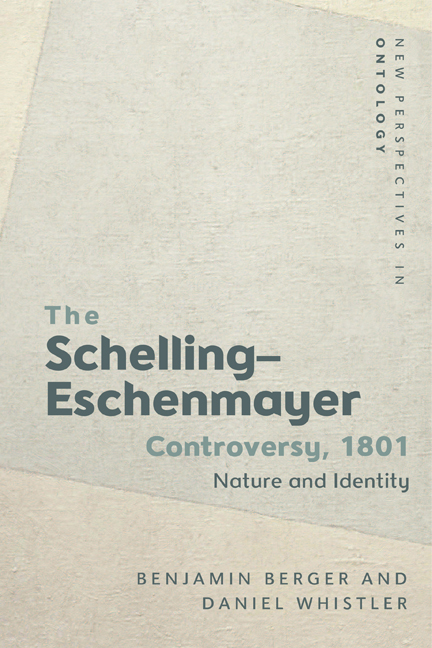Book contents
- Frontmatter
- Contents
- Preface
- Translators’ Note
- Abbreviations
- Introduction: Schelling and Eschenmayer in 1801
- Part I Texts
- Spontaneity = World Soul, or the Highest Principle of Philosophy of Nature
- On the True Concept of Philosophy of Nature and the Correct Way of Solving its Problems
- Part II Commentaries
- 1 Quality
- 2 Potency
- 3 Identity
- 4 Drive
- 5 Abstraction
- Part III Appendices
- Appendix 1 Correspondence, 1799–1801
- Appendix 2 Principles of Nature-Metaphysics Applied to Chemical and Medical Subjects [Extracts]
- Appendix 3 Deduction of the Living Organism [Extracts]
- Appendix 4 Review of F. W. J. Schelling’s First Outline of a System of Philosophy of Nature and Introduction to his Outline
- Notes
- Bibliography
- Index
4 - Drive
Published online by Cambridge University Press: 03 October 2020
- Frontmatter
- Contents
- Preface
- Translators’ Note
- Abbreviations
- Introduction: Schelling and Eschenmayer in 1801
- Part I Texts
- Spontaneity = World Soul, or the Highest Principle of Philosophy of Nature
- On the True Concept of Philosophy of Nature and the Correct Way of Solving its Problems
- Part II Commentaries
- 1 Quality
- 2 Potency
- 3 Identity
- 4 Drive
- 5 Abstraction
- Part III Appendices
- Appendix 1 Correspondence, 1799–1801
- Appendix 2 Principles of Nature-Metaphysics Applied to Chemical and Medical Subjects [Extracts]
- Appendix 3 Deduction of the Living Organism [Extracts]
- Appendix 4 Review of F. W. J. Schelling’s First Outline of a System of Philosophy of Nature and Introduction to his Outline
- Notes
- Bibliography
- Index
Summary
In the first three chapters of commentary, we focused on various ways philosophers of nature have accounted for the qualitative differences that abound in the natural world. We sought to demonstrate that Schelling's engagement with Eschenmayer on this topic led him to adopt the mathematical concept of ‘potency’ and articulate the metaphysical position of the 1801 Presentation, in which all determinacy in nature is explained in terms of quantitative difference or varying degrees of ‘identity’.
We now turn to what Schelling and Eschenmayer understood to be the crux of their debate: the possibility, significance, and methodology of an idealist philosophy of nature. In Spontaneity = World Souland his later review of Schelling's First Outline, Eschenmayer argues that idealist philosophy of nature ought to be pursued from a transcendental perspective. In On the True Concept, Schelling rejects this transcendental approach to the philosophy of nature in no uncertain terms and proposes a radical method of abstraction in which the philosopher no longer identifies with the reflective activity of the I but with the activity of nature itself. The full significance of Schelling's proposal will only become apparent in Chapter 5, in which we consider Schelling's theoretical account of abstraction in On the True Conceptand the way abstraction is put into practice in the Presentation. At this point, it is necessary to explore the different ways that Eschenmayer and Schelling view the aims of the philosophy of nature and the manner in which these aims are shaped by a fundamental metaphysical disagreement between them. While Eschenmayer locates the original source of nature's activity in the spontaneity of the I, Schelling argues that there is a more fundamental activity in the inorganic world, an activity which only achieves consciousness – that is, only becomesan I – as a result of an atemporal, ontological development of non-conscious being. The former view leads Eschenmayer to understand the philosopher's task as the derivation of the diverse range of natural processes from the original activity of consciousness; the latter view leads Schelling to argue that the philosopher of nature must bracket the structure of consciousness altogether in order to exhibit, in philosophical reason, the activity of nature quanature.
- Type
- Chapter
- Information
- The Schelling-Eschenmayer Controversy, 1801Nature and Identity, pp. 139 - 161Publisher: Edinburgh University PressPrint publication year: 2020

